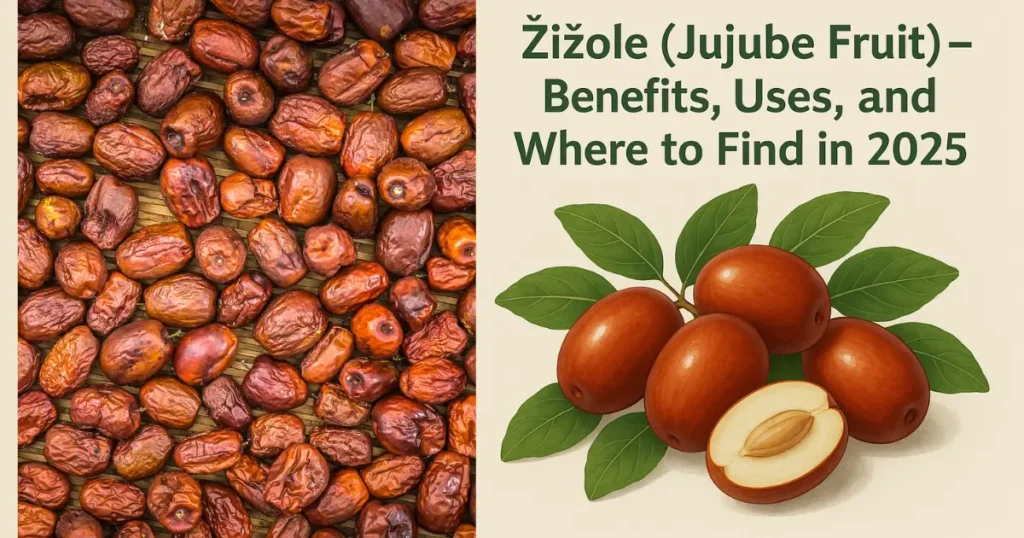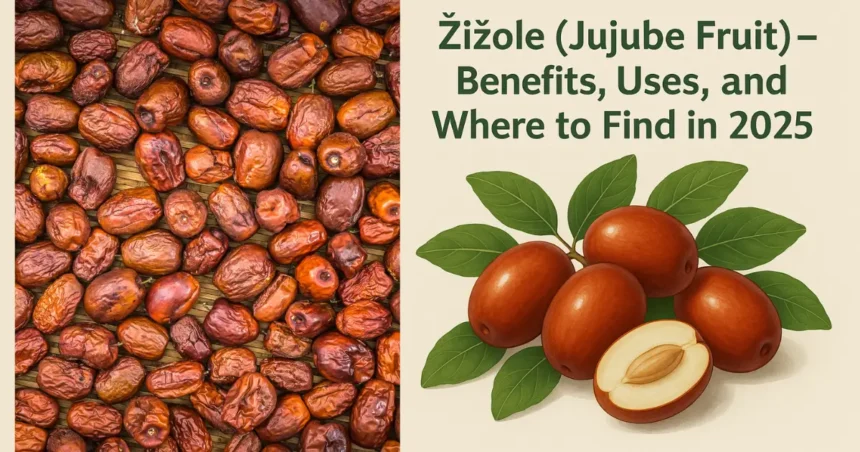
Žižole, also known as jujube or ziziphus jujuba, are small, round-to-oval fruits native to regions of Asia and the Mediterranean. Despite being called “Chinese dates,” they are not real dates but rather stone fruits with a crisp texture (when fresh) and chewy sweetness (when dried).
Basic Facts:
- Scientific Name: Ziziphus jujuba
- Common Names: Žižole, Čičimak, Chinese Date, Red Date, Kineski datulj
- Origin: Asia (China, Korea), spread across Europe
- Taste: Similar to a mild apple, becomes sweet and prune-like when dried
- Family: Rhamnaceae (Buckthorn family)
Origins and Etymology
The name žižola is often used in Croatia, Slovenia, Bosnia and Montenegro, rooted in ancient Slavic and Latinized sources.
- Latin: Ziziphus
- Greek: Zizyphos
- Chinese: “红枣” (hóng zǎo)
- Arabic: “sidr” or “nabq”
The fruit likely migrated via Silk Road travel and Mediterranean trade routes hundreds of years ago.
Where Are Žižole Grown Today?
Žižole in the Balkans and the Mediterranean
In countries like Croatia, Montenegro, and Albania, are considered old-world fruits — often forgotten but treasured in rural areas, especially:
- Dalmatian coast (Croatia)
- Kotor Bay (Montenegro)
- Peljesac peninsula
- Rural Sicily, Crete, and Cyprus
Here, they’re grown in small orchards or backyards, used in jams, teas, and liqueurs.
Žižole in China and Asia
In China, the jujube is elevated to superfood status.
- Used in Traditional Chinese Medicine (TCM)
- Sung about in Tang Dynasty poetry
- Sold in supermarkets as candy, tea bags, and powder
Nutritional Value & Health Benefits
Per 100 grams of dried žižole:
| Nutrient | Value |
|---|---|
| Calories | 287 kcal |
| Carbohydrates | 73g |
| Fiber | 6g |
| Vitamin C | 20 mg |
| Iron | 1 mg |
| Antioxidants | High (flavonoids, polysaccharides) |
Top 8 Health Benefits
- Boosts immunity (thanks to high Vitamin C)
- Improves digestion (dietary fiber + gut prebiotics)
- Supports mental clarity (used in herbal medicine for anxiety)
- Reduces inflammation
- Balances blood sugar (especially when consumed dried)
- Promotes restful sleep (as žižole tea)
- Supports liver health
- Balances hormones in women
How To Eat Žižole (Fresh, Dried, Tea)
Fresh
- Eaten like apples — washed & whole
- Crunchy texture, slightly sour-sweet flavor
- Best enjoyed from September to November
Dried
- Sold in Asian supermarkets or health food shops
- Chewier, naturally sweet
- Used in trail mixes, baking, stews, soups
Tea
Boil 4–5 dried žižole, simmer for 10 minutes, and enjoy a calming evening tea.
Variants:
- With ginger for warming effect
- With goji berries & cinnamon
- Ice brew with lemon for a summer health tonic
Traditional and Modern Uses
- Medicinal syrups used in Ayurveda and TCM
- Jam/jelly recipes in the Mediterranean
- Liqueurs & rakija infused with žižole
- Modern pastries and energy bars
Where To Buy Žižole in 2025
Fresh (seasonal):
- Local farmers’ markets (Balkans)
- Specialty organic markets
Dried & Powdered:
| Store | Availability |
|---|---|
| Amazon EU | Dried whole and pitted |
| iHerb.com | Jujube powder / capsule |
| Natura Bio Croatia (Local) | Fresh + Jam |
| Chinese herbal shops (globally) | Raw and processed |
Žižole Recipes You Can Try Today
1. Žižole & Apple Jam
Cook down fresh žižole with apples, cinnamon, lemon juice, and a touch of honey.
2. Baked Žižole Chips
Slice + oven-dry for crunchy chips with a honey glaze.
3. Žižole Stuffed Dates (Twist!)
Swap for regular dates in Moroccan-style recipes for a healthier version.
FAQs About Žižole
Are žižole and dates the same thing?
No, (jujubes) are not dates. They simply resemble dried dates when matured.
What do žižole taste like?
Fresh — similar to a tart apple.
Dried — a cross between a prune and a date.
Are žižole safe during pregnancy?
Yes, but in moderation. They’re rich in Iron and Vitamin C, which aid circulation and immunity. Consult a healthcare provider for personalized advice.
How long do dried žižole last?
Stored in a cool, dark place, dried last 6 to 12 months.
Conclusion: Why Žižole Deserve a Spot in Your Diet
Žižole are more than a nostalgic countryside fruit — they’re a functional food, a far-reaching traditional medicine, and now an ingredient in emerging recipes, teas, and wellness products.
In 2025, as consumers explore more natural and locally-rooted superfoods, it’s time is given the attention it deserves.








